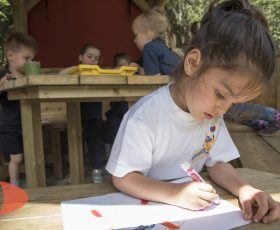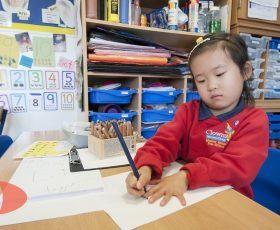The Rhythm Group at Clowns is a great opportunity for the children to further develop their sense of rhythm and build their confidence in making music. Classes are 30 minutes long with up to 12 children per class. The lessons run over three terms and there are 10 lessons per term. They are designed to be fun, relaxed and engaging.
In many different cultures and using teaching methods from across the world, children learn about a variety of musical genres from classical to jazz and samba to Indian folk music. They practice with different percussion instruments and learn rhythm first, before moving on to melody and harmony instruments like the piano, guitar or sitar.
Lessons are centred around using a variety of drums such as the Conga drum, Bongos and Tom Tom drums. We also explore percussion instruments such as triangles, shakers and tambourines. Each term we choose a topic and theme the children are interested in such as ‘The Jungle’ or ‘Food’ and sing songs and play musical games based around these topics. We also use movement and dance to keep the lessons interesting and challenging and the energy levels high!
Rhythm exercises and games such as question and answer phrases or taking turns to lead the group are additional methods we use to structure the lessons. If the topic is ‘Food’ we may, for example, pass around a drum and tap out the syllables to our favourite food names, whilst the rest of the group keep a steady clapping rhythm going.
Body percussion is another way we use rhythm for songs and games such as, stamping feet, tapping our knees or chest and singing a song over the top. This is a great way of building co-ordination and something the children can practice anywhere, anytime.
A typical lesson will usually run as follows:
- Introductory song and warm up using our voices, body and drums.
- Recall of the previous weeks songs to build a repertoire of music we can confidently play.
- Instrument technique for that week’s focus instrument. ‘How do you hold a triangle correctly?’. ‘How can we get different sounds from a bongo drum?’
- Basic music theory skills, covering time signatures (counting), tempo (slow or fast), dynamics (loud or soft). ‘Can you tap this written rhythm?’
- Movement and dancing songs using ribbons or colourful scarfs.
- Group call and answer songs such as ‘Shay shay koolay’.
- Circle game songs. For example, passing a rhythm around the circle.
- Question and answer phrases and group leading exercises.


